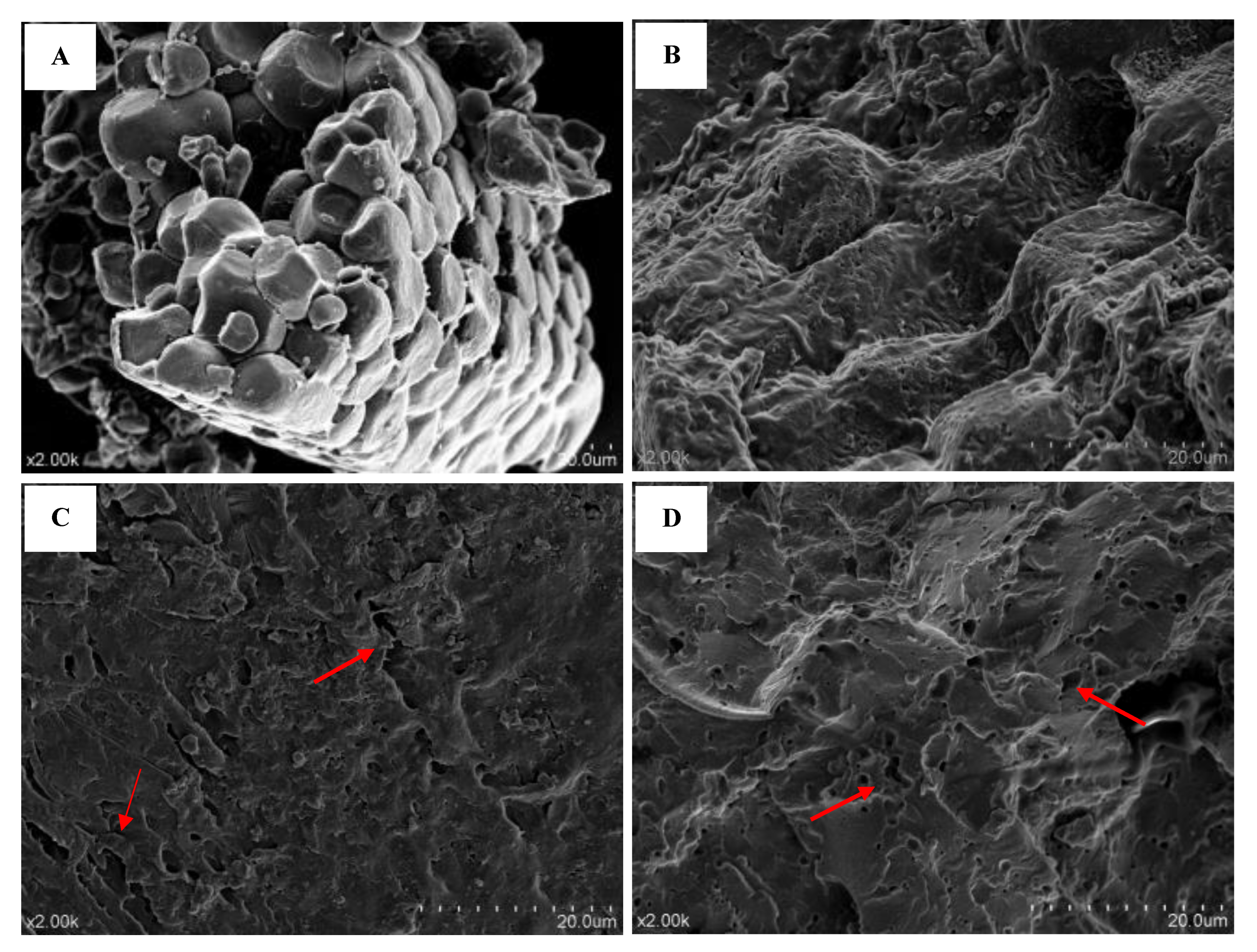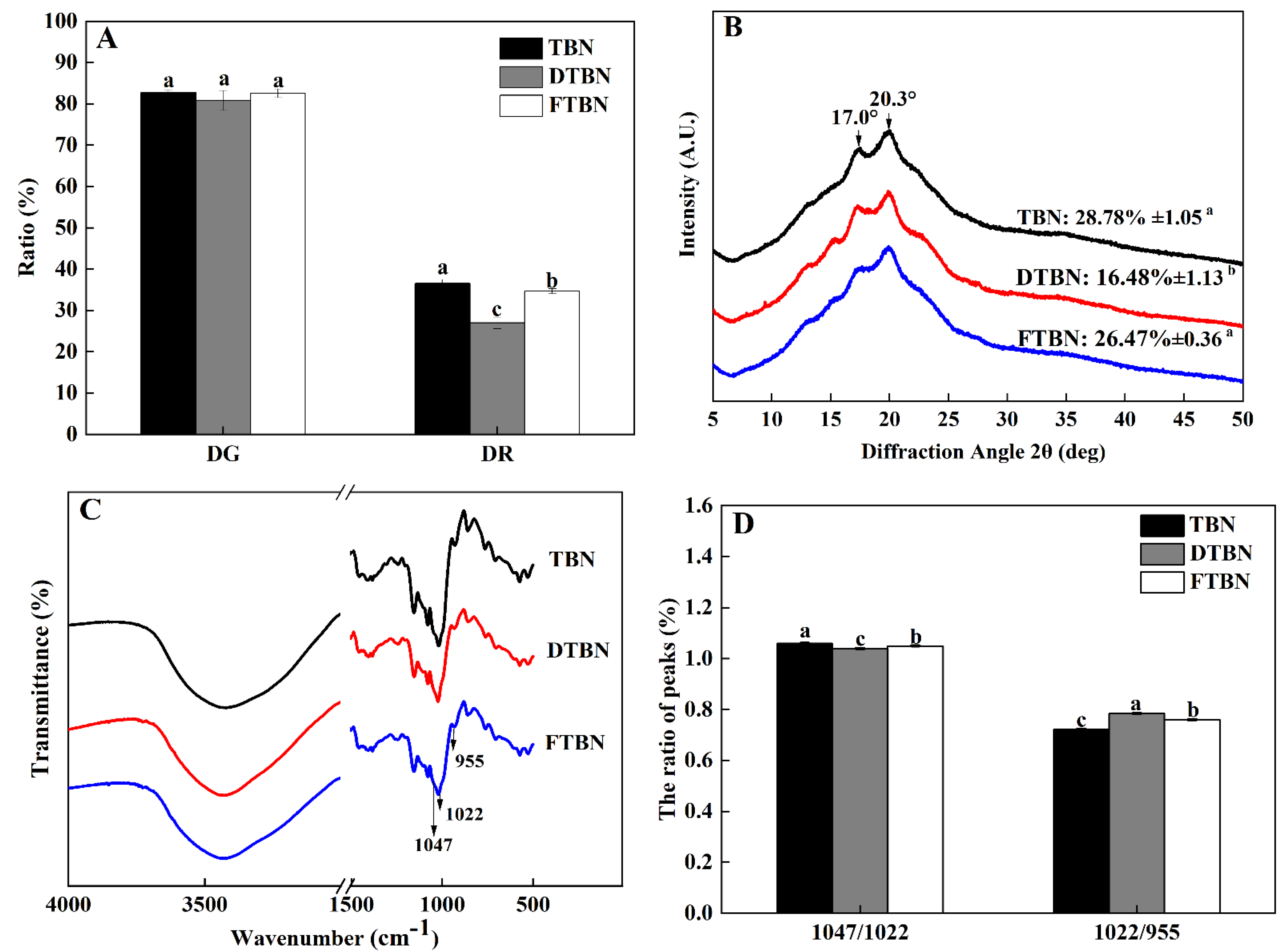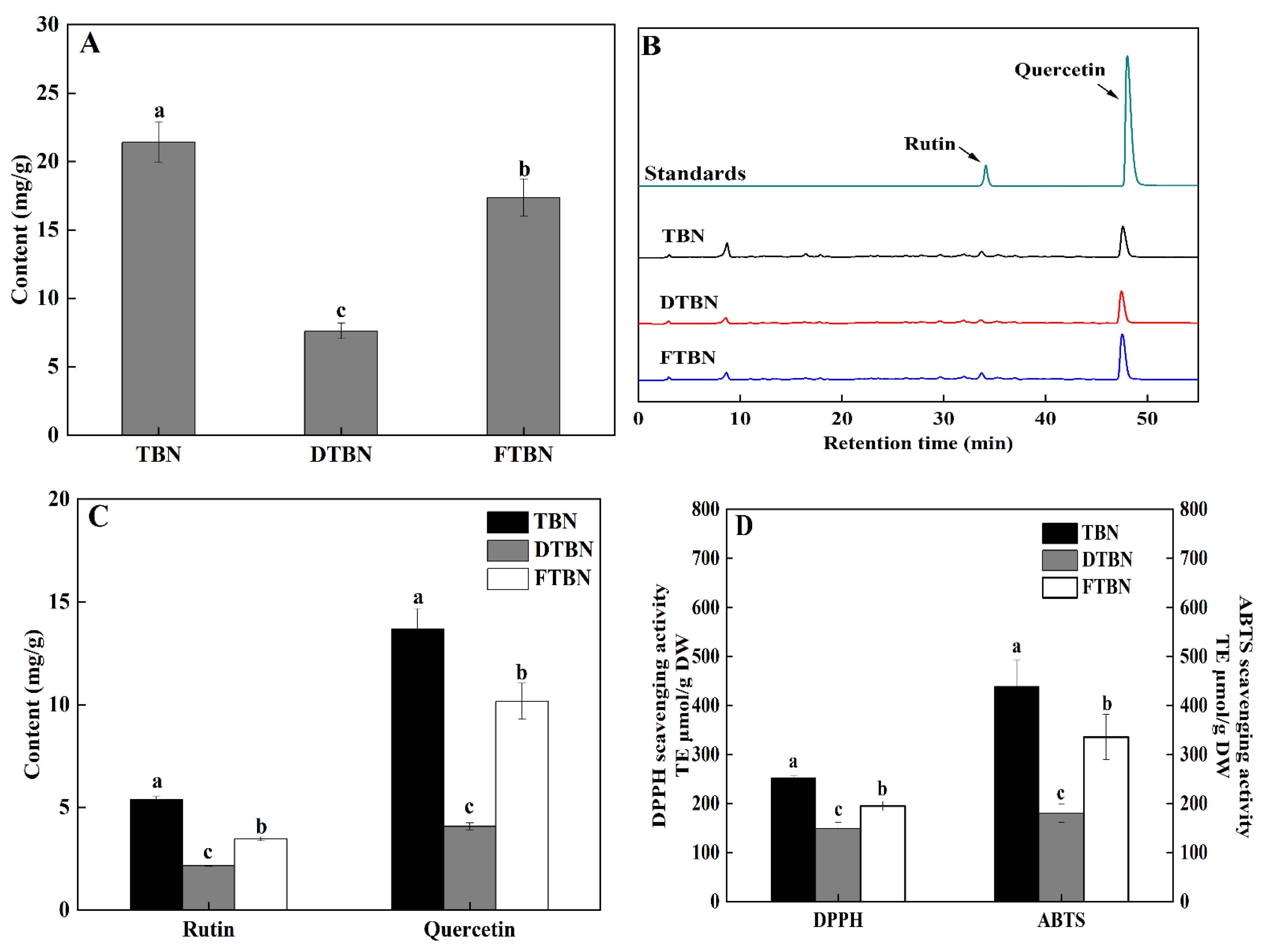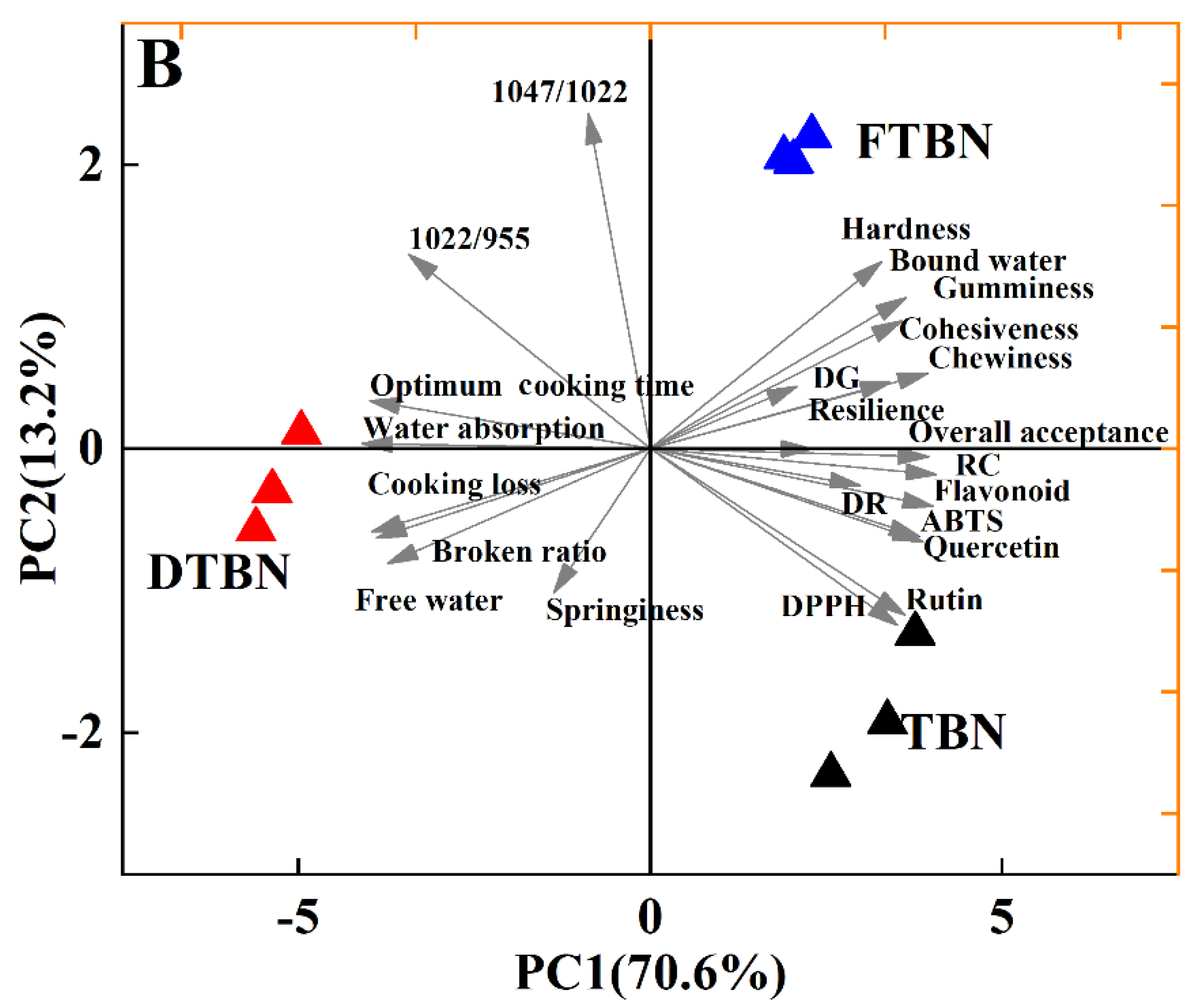Effect of Frozen Treatment on the Sensory and Functional Quality of Extruded Fresh Noodles Made from Whole Tartary Buckwheat
Abstract
:1. Introduction
2. Materials and Methods
2.1. Materials
2.2. Preparation of Tartary Buckwheat Noodles
2.3. Cooking Quality of Noodles
2.3.1. Optimum Cooking Time
2.3.2. Water Absorption
2.3.3. Broken Ratio
2.3.4. Cooking Loss
2.4. Texture Profile Analysis (TPA)
2.5. Sensory Evaluation
2.6. Scanning Electron Microscopy (SEM) Analysis
2.7. Water Distribution in Cooked Tartary Buckwheat Noodles
2.8. Degree of Starch Gelatinization (DG) and Retrogradation (DR)
2.9. X-ray Diffraction (XRD)
2.10. Fourier Transform Infrared (FTIR) Spectroscopy
2.11. Determination of Flavonoids Content and Antioxidant Activities
2.11.1. Total Flavonoid Content
2.11.2. Rutin and Quercetin Content
2.11.3. DPPH Radical Scavenging Activity
2.11.4. ABTS Radical Scavenging Capacity
2.12. Statistical Analysis
3. Results and Discussion
3.1. Effect of Frozen Treatment on Cooking Quality of Noodles
3.2. Effect of Frozen Treatment on Textural Quality of Noodles
3.3. Different Acceptance in Sensory Quality of Frozen Noodles from Dried Noodles
3.4. Change in the Microstructure of Noodles
3.5. Changes in Water Distribution of Cooked Tartary Buckwheat Noodles
3.6. Roles of Starch Retrogradation in Cooking Quality of Tartary Buckwheat Noodles
3.7. Effect of the Crystalline Starch Structure of Noodles on Different Treatments
3.8. Changes in the Short-Range Starch Structure of Noodles
3.9. Effect of Frozen Treatment on the Functional Property of Tartary Buckwheat Noodles
3.10. Correlation Analysis on Noodle Quality with Frozen Treatment and Hot Air Drying
4. Conclusions
Author Contributions
Funding
Data Availability Statement
Acknowledgments
Conflicts of Interest
References
- Wang, L.; Wang, L.; Li, Z.; Gao, Y.; Cui, S.W.; Wang, T.; Qiu, J. Diverse effects of rutin and quercetin on the pasting, rheological and structural properties of Tartary buckwheat starch. Food Chem. 2021, 335, 127556. [Google Scholar] [CrossRef] [PubMed]
- Zhu, F. Chemical composition and health effects of Tartary buckwheat. Food Chem. 2016, 203, 231–245. [Google Scholar] [CrossRef] [PubMed]
- Wang, Y.-H.; Zhang, Y.-R.; Xu, F.; Zhang, Y.-L. Effect of boiling and steaming on the surface tackiness of frozen cooked noodles. LWT—Food Sci. Technol. 2020, 130, 109747. [Google Scholar] [CrossRef]
- Sun, X.; Yu, C.; Fu, M.; Wu, D.; Gao, C.; Feng, X.; Cheng, W.; Shen, X.; Tang, X. Extruded whole buckwheat noodles: Effects of processing variables on the degree of starch gelatinization, changes of nutritional components, cooking characteristics and in vitro starch digestibility. Food Funct. 2019, 10, 6362–6373. [Google Scholar] [CrossRef]
- Puligundla, P.; Lim, S. Buckwheat noodles: Processing and quality enhancement. Food Sci. Biotechnol. 2021, 30, 1471–1480. [Google Scholar] [CrossRef]
- Xiang, Z.; Ye, F.; Zhou, Y.; Wang, L.; Zhao, G. Performance and mechanism of an innovative humidity-controlled hot-air drying method for concentrated starch gels: A case of sweet potato starch noodles. Food Chem. 2018, 269, 193–201. [Google Scholar] [CrossRef]
- Bao, H.; Zhou, J.; Yu, J.; Wang, S. Effect of drying methods on properties of potato flour and noodles made with potato flour. Foods 2021, 10, 1115. [Google Scholar] [CrossRef]
- Lin, Q.; Ren, A.; Liu, R.; Xing, Y.; Yu, X.; Jiang, H. Flavor properties of Chinese noodles processed by dielectric drying. Front. Nutr. 2022, 9, 1007997. [Google Scholar] [CrossRef]
- Zhang, K.; Zhao, D.; Ma, X.; Guo, D.; Tong, X.; Zhang, Y.; Qu, L. Effect of different starch acetates on the quality characteristics of frozen cooked noodles. Food Sci. Nutr. 2022, 10, 678–688. [Google Scholar] [CrossRef]
- Zhu, F. Frozen steamed breads and boiled noodles: Quality affected by ingredients and processing. Food Chem. 2021, 349, 129178. [Google Scholar] [CrossRef]
- Gong, Y.; Xu, S.; He, T.; Dong, R.; Ren, T.; Wang, X.; Hu, X. Effect of quick-freezing temperature on starch retrogradation and ice crystals properties of steamed oat roll. J. Cereal Sci. 2020, 96, 103109. [Google Scholar] [CrossRef]
- Detchewa, P.; Prasajak, P.; Phungamngoen, C.; Sriwichai, W.; Naivikul, O.; Moongngarm, A. Substitution of rice flour with rice protein improved quality of gluten-free rice spaghetti processed using single screw extrusion. LWT—Food Sci. Technol. 2022, 153, 112512. [Google Scholar] [CrossRef]
- Fu, M.; Sun, X.; Wu, D.; Meng, L.; Feng, X.; Cheng, W.; Gao, C.; Yang, Y.; Shen, X.; Tang, X. Effect of partial substitution of buckwheat on cooking characteristics, nutritional composition, and in vitro starch digestibility of extruded gluten-free rice noodles. LWT—Food Sci. Technol. 2020, 126, 109332. [Google Scholar] [CrossRef]
- Zou, S.; Wang, L.; Wang, A.; Zhang, Q.; Li, Z.; Qiu, J. Effect of Moisture Distribution Changes Induced by Different Cooking Temperature on Cooking Quality and Texture Properties of Noodles Made from Whole Tartary Buckwheat. Foods 2021, 10, 2543. [Google Scholar] [CrossRef] [PubMed]
- Sun, X.; Li, W.; Hu, Y.; Zhou, X.; Ji, M.; Yu, D.; Fujita, K.; Tatsumi, E.; Luan, G. Comparison of pregelatinization methods on physicochemical, functional and structural properties of Tartary buckwheat flour and noodle quality. J. Cereal Sci. 2018, 80, 63–71. [Google Scholar] [CrossRef]
- Kim, J.O.; Kim, W.S.; Shin, M.S. A comparative study on retrogradation of rice starch gels by DSC, X-ray and alpha-amylase methods. Starch-Stärke 1997, 49, 71–75. [Google Scholar] [CrossRef]
- Spagnol, C.M.; Assis, R.P.; Brunetti, I.L.; Isaac, V.L.B.; Salgado, H.R.N.; Correa, M.A. In vitro methods to determine the antioxidant activity of caffeic acid. Spectrochim. Acta Part A Molecuar Biomol. Spectrosc. 2019, 219, 358–366. [Google Scholar] [CrossRef]
- Cao, Z.; Liu, Y.; Zhu, H.; Li, Y.; Xiao, Q.; Yi, C. Effect of Soy Protein Isolate on Textural Properties, Cooking Properties and Flavor of Whole-Grain Flat Rice Noodles. Foods 2021, 10, 1085. [Google Scholar] [CrossRef]
- Wang, Y.-H.; Zhang, Y.-R.; Yang, Y.-Y.; Shen, J.-Q.; Zhang, Q.-M.; Zhang, G.-Z. Effect of wheat gluten addition on the texture, surface tackiness, protein structure, and sensory properties of frozen cooked noodles. LWT—Food Sci. Technol. 2022, 161, 113348. [Google Scholar] [CrossRef]
- Cao, Y.; Zhao, J.; Jin, Z.; Tian, Y.; Zhou, X.; Long, J. Improvement of rice bran modified by extrusion combined with ball milling on the quality of steamed brown rice cake. J. Cereal Sci. 2021, 99, 103229. [Google Scholar] [CrossRef]
- Li, M.; Luo, L.-J.; Zhu, K.-X.; Guo, X.-N.; Peng, W.; Zhou, H.-M. Effect of vacuum mixing on the quality characteristics of fresh noodles. J. Food Eng. 2012, 110, 525–531. [Google Scholar] [CrossRef]
- Wang, R.; Li, M.; Chen, S.; Hui, Y.; Tang, A.; Wei, Y. Effects of flour dynamic viscosity on the quality properties of buckwheat noodles. Carbohydr. Polym. 2019, 207, 815–823. [Google Scholar] [CrossRef] [PubMed]
- Han, X.; Xing, J.; Han, C.; Guo, X.; Zhu, K. The effects of extruded endogenous starch on the processing properties of gluten-free Tartary buckwheat noodles. Carbohydr. Polym. 2021, 267, 118170. [Google Scholar] [CrossRef] [PubMed]
- Obadi, M.; Zhang, J.; Shi, Y.; Xu, B. Factors affecting frozen cooked noodle quality: A review. Trends Food Sci. Technol. 2021, 109, 662–673. [Google Scholar] [CrossRef]
- Bustos, M.C.; Perez, G.T.; Leon, A.E. Structure and quality of pasta enriched with functional ingredients. RSC Adv. 2015, 5, 30780–30792. [Google Scholar] [CrossRef]
- Wang, S.; Li, C.; Copeland, L.; Niu, Q.; Wang, S. Starch Retrogradation: A Comprehensive Review. Compr. Rev. Food Sci. Food Saf. 2015, 14, 568–585. [Google Scholar] [CrossRef]
- Qiu, S.; Punzalan, M.E.; Abbaspourrad, A.; Padilla-Zakour, O.I. High water content, maltose and sodium dodecyl sulfate were effective in preventing the long-term retrogradation of glutinous rice grains—A comparative study. Food Hydrocoll. 2020, 98, 105247. [Google Scholar] [CrossRef]
- Gao, L.; Wang, H.; Wan, C.; Leng, J.; Wang, P.; Yang, P.; Gao, X.; Gao, J. Structural, pasting and thermal properties of common buckwheat (Fagopyrum esculentum Moench) starches affected by molecular structure. Int. J. Biol. Macromol. 2020, 156, 120–126. [Google Scholar] [CrossRef]
- Yang, Z.; Zhang, Y.; Wu, Y.; Ouyang, J. The role of drying methods in determining the in vitro digestibility of starch in whole chestnut flour. LWT—Food Sci. Technol. 2022, 153, 112583. [Google Scholar] [CrossRef]
- Miao, W.; Ning, Y.; Huang, H.; Liu, H.; Cai, X.; Wang, X. Effect of dry heat modification and the addition of Chinese quince seed gum on the physicochemical properties and structure of tigernut tuber starch. Arab. J. Chem. 2021, 14, 103407. [Google Scholar] [CrossRef]
- Padalino, L.; Caliandro, R.; Chita, G.; Conte, A.; Del Nobile, M.A. Study of drying process on starch structural properties and their effect on semolina pasta sensory quality. Carbohydr. Polym. 2016, 153, 229–235. [Google Scholar] [CrossRef] [PubMed]
- Yu, S.; Ma, Y.; Sun, D.W. Effects of freezing rates on starch retrogradation and textural properties of cooked rice during storage. LWT—Food Sci. Technol. 2010, 43, 1138–1143. [Google Scholar] [CrossRef]
- Sun, X.; Meng, L.; Tang, X. Retrogradation behavior of extruded whole buckwheat noodles: An innovative water pre-cooling retrogradation treatment. J. Cereal Sci. 2021, 99, 103234. [Google Scholar] [CrossRef]
- Yang, Q.; Zhang, W.; Luo, Y.; Li, J.; Gao, J.; Yang, P.; Gao, X.; Feng, B. Comparison of structural and physicochemical properties of starches from five coarse grains. Food Chem. 2019, 288, 283–290. [Google Scholar] [CrossRef] [PubMed]
- Ren, F.; Nian, Y.; Perussello, C.A. Effect of storage, food processing and novel extraction technologies on onions flavonoid content: A review. Food Res. Int. 2020, 132, 108953. [Google Scholar] [CrossRef]
- Germ, M.; Arvay, J.; Vollmannova, A.; Toth, T.; Golob, A.; Luthar, Z.; Kreft, I. The temperature threshold for the transformation of rutin to quercetin in Tartary buckwheat dough. Food Chem. 2019, 283, 28–31. [Google Scholar] [CrossRef]







| TBN | DTBN | FTBN | ||
|---|---|---|---|---|
| Cooking quality | Optimum cooking time/min | 3.00 ± 0.10 c | 17.00 ± 3.20 a | 7.00 ± 0.70 b |
| Water absorption/% | 61.56 ± 1.68 c | 189.79 ± 9.34 a | 78.10 ± 2.76 b | |
| Broken ratio/% | 5.00 ± 1.00 b | 28.33 ± 3.06 a | 0 ± 0 c | |
| Cooking loss/% | 8.23 ± 0.02 b | 21.88 ± 0.98 a | 5.85 ± 0.64 b | |
| Texture profile | Hardness/g | 7195.94 ± 219.01 a | 5502.98 ± 362.17 b | 8656.99 ± 568.10 a |
| Gumminess/g | 4773.56 ± 445.38 a | 2885.53 ± 186.80 b | 5640.66 ± 353.75 a | |
| Chewiness/g | 3676.57 ± 195.00 a | 2405.87 ± 172.29 b | 3841.75 ± 130.29 a | |
| Springiness/% | 0.77 ± 0.03 a | 0.82 ± 0.06 a | 0.66 ± 0.11 a | |
| Cohesiveness/% | 0.66 ± 0.09 a | 0.52 ± 0.01 a | 0.66 ± 0.04 a | |
| Resilience/% | 0.37 ± 0.14 a | 0.28 ± 0.04 b | 0.34 ± 0.03 a | |
| Sensory quality | Color | 7.07 ± 0.99 a | 7.06 ± 0.98 a | 7.80 ± 0.69 a |
| Appearance | 8.00 ± 0.66 a | 5.50 ± 0.34 b | 8.20 ± 0.64 a | |
| Smoothness | 8.40 ± 0.51 a | 4.50 ± 0.17 c | 7.60 ± 0.45 a | |
| Firmness | 8.70 ± 1.42 a | 5.55 ± 0.16 b | 7.80 ± 0.87 a | |
| Elasticity | 8.85 ± 0.33 a | 6.20 ± 0.48 b | 8.40 ± 0.69 a | |
| Stickiness | 7.60 ± 0.51 a | 5.20 ± 0.42 b | 7.00 ± 0.80 a | |
| Flavor | 6.40 ± 0.30 a | 5.20 ± 0.43 b | 6.55 ± 0.39 a | |
| Overall acceptance | 8.35 ± 0.58 a | 5.20 ± 0.63 b | 7.90 ± 0.86 a | |
Publisher’s Note: MDPI stays neutral with regard to jurisdictional claims in published maps and institutional affiliations. |
© 2022 by the authors. Licensee MDPI, Basel, Switzerland. This article is an open access article distributed under the terms and conditions of the Creative Commons Attribution (CC BY) license (https://creativecommons.org/licenses/by/4.0/).
Share and Cite
Guo, Z.; Wang, L.; Cao, R.; Qiu, J. Effect of Frozen Treatment on the Sensory and Functional Quality of Extruded Fresh Noodles Made from Whole Tartary Buckwheat. Foods 2022, 11, 3989. https://doi.org/10.3390/foods11243989
Guo Z, Wang L, Cao R, Qiu J. Effect of Frozen Treatment on the Sensory and Functional Quality of Extruded Fresh Noodles Made from Whole Tartary Buckwheat. Foods. 2022; 11(24):3989. https://doi.org/10.3390/foods11243989
Chicago/Turabian StyleGuo, Zicong, Lijuan Wang, Ruge Cao, and Ju Qiu. 2022. "Effect of Frozen Treatment on the Sensory and Functional Quality of Extruded Fresh Noodles Made from Whole Tartary Buckwheat" Foods 11, no. 24: 3989. https://doi.org/10.3390/foods11243989
APA StyleGuo, Z., Wang, L., Cao, R., & Qiu, J. (2022). Effect of Frozen Treatment on the Sensory and Functional Quality of Extruded Fresh Noodles Made from Whole Tartary Buckwheat. Foods, 11(24), 3989. https://doi.org/10.3390/foods11243989







